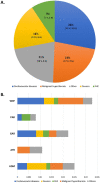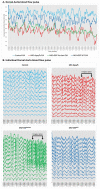Analysis of incidental findings in Qatar genome participants reveals novel functional variants in LMNA and DSP
- PMID: 35348702
- PMCID: PMC9402234
- DOI: 10.1093/hmg/ddac073
Analysis of incidental findings in Qatar genome participants reveals novel functional variants in LMNA and DSP
Abstract
In order to report clinically actionable incidental findings in genetic testing, the American College of Medical Genetics and Genomics (ACMG) recommended the evaluation of variants in 59 genes associated with highly penetrant mutations. However, there is a lack of epidemiological data on medically actionable rare variants in these genes in Arab populations. We used whole genome sequencing data from 6045 participants from the Qatar Genome Programme and integrated it with phenotypic data collected by the Qatar Biobank. We identified novel putative pathogenic variants in the 59 ACMG genes by filtering previously unrecorded variants based on computational prediction of pathogenicity, variant rarity and segregation evidence. We assessed the phenotypic associations of candidate variants in genes linked to cardiovascular diseases. Finally, we used a zebrafish knockdown and synthetic human mRNA co-injection assay to functionally characterize two of these novel variants. We assessed the zebrafish cardiac function in terms of heart rate, rhythm and hemodynamics, as well as the heart structure. We identified 52 492 novel variants, which have not been reported in global and disease-specific databases. A total of 74 novel variants were selected with potentially pathogenic effect. We prioritized two novel cardiovascular variants, DSP c.1841A > G (p.Asp614Gly) and LMNA c.326 T > G (p.Val109Gly) for functional characterization. Our results showed that both variants resulted in abnormal zebrafish heart rate, rhythm and structure. This study highlights medically actionable variants that are specific to the Middle Eastern Qatari population.
© The Author(s) 2022. Published by Oxford University Press.
Figures





References
-
- Kalia, S.S., Adelman, K., Bale, S.J., Chung, W.K., Eng, C., Evans, J.P., Herman, G.E., Hufnagel, S.B., Klein, T.E., Korf, B.R.et al. (2017) Recommendations for reporting of secondary findings in clinical exome and genome sequencing, 2016 update (ACMG SF v2.0): a policy statement of the American College of Medical Genetics and Genomics. Genet. Med., 19, 249–255. - PubMed
MeSH terms
Substances
LinkOut - more resources
Full Text Sources
Molecular Biology Databases
Miscellaneous

